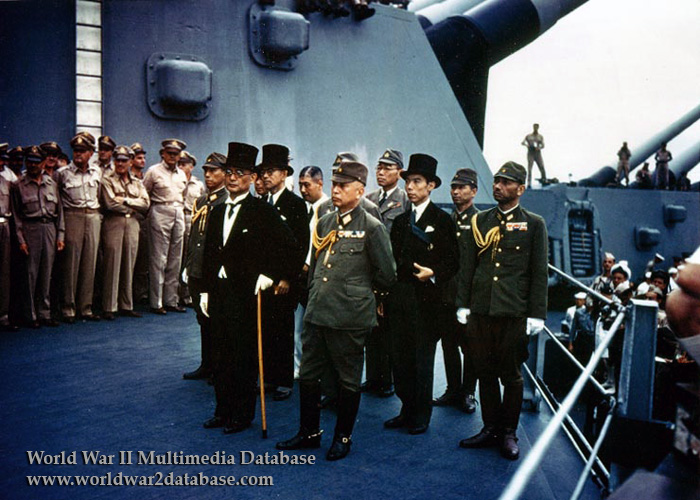| Japanese representatives arrive on board USS Missouri (BB-63) during the surrender ceremonies, September 2, 1945. Standing in front are: Foreign Minister Mamoru Shigemitsu (July 29, 1887-June 27, 1957), with cane and wearing top hat, convicted of war crimes by taking part in Unit 731, and sentenced to seven years imprisonment. He was paroled in 1950, and again served as Foreign minister (1954-1956). In 1932, he was wounded by a Korean nationalist activist in Shanghai, China and lost his leg. He walked with an artificial leg and cane for the rest of his life. General Yoshijiro Umezu (January 4, 1882 – January 8, 1949), Chief of the Imperial Japanese Army General Staff; opposed surrender in August of 1945; he believed that the military should fight on, forcing the Allies to sustain heavy losses in a ground invasion of Japan, and that only this way could Japan negotiate for better peace terms. After the war he was tried as a war criminal along with other senior Japanese officials (see International Military Tribunal for the Far East, and sentenced to life imprisonment on November 12, 1948. He died in prison. In middle row, left to right: Major General Yatsuji Nagai (January 20, 1901 – August 15, 1970), Head of the Military Affairs Section of the General Staff, Imperial Japanese Army. Burned in air attack in May 1945. The youngest Japanese Major General. Katsuo Okazaki (July 10, 1897 – October 10, 1965), Foreign Ministry, part of peace delegation to the Americans on Ie Shima; Japanese minister for relations to the United States between 1951 and 1954. Rear Admiral Tadatoshi Tomioka (March 8, 1897 – December 7, 1970), Chief Operations Section of the Naval General Staff, Imperial Japanese Navy. Helped plan the attack on Pearl Harbor. Toshikazu Kase (January 12, 1903 – May 21, 2004), Foreign Ministry, Head of Section 3, Intelligence Bureau. Kase said “I was the one who advocated wearing those swallow coats, not because we want to pay respect to American generals, but because we were representing our sovereign,“ he said, referring to Emperor Hirohito. “I had to borrow a top hat, but it was too small. It didn‘t matter because I had to hold it. There was a lot of wind on the deck.“ He served in diplomatic posts in Washington, London, Berlin and Tokyo from 1927-1960. Attended Amherst College. Lieutenant General Suichi Miyakazi (February 6, 1895 – October 16, 1969), Chief of Section One of the General Staff, Imperial Japanese Army. In the the back row, left to right (not all are visible): Rear Admiral Ichiro Yokoyama (March 1, 1900 – July 28, 1993), Imperial Japanese Navy; Saburo Ohta (1905 – ????), Foreign Ministry; Captain Katsuo Shiba (September 4, 1901 – January 3 , 1970), Imperial Japanese Navy, and Colonel Kaziyi Sugita (March 31, 1904 – April 12, 1993), War Ministry, Imperial Japanese Army. | |
| Image Filename | wwii1141.jpg |
| Image Size | 195.71 KB |
| Image Dimensions | 700 x 500 |
| Photographer | Unknown |
| Photographer Title | |
| Caption Author | Jason McDonald |
| Date Photographed | September 02, 1945 |
| Location | United States Missouri (BB-63) |
| City | Tokyo Bay |
| State or Province | Tokyo Prefecture |
| Country | Japan |
| Archive | United States Naval Historical Center |
| Record Number | |
| Status | Caption ©2007, ©2024 MFA Productions LLC Image in the Public Domain |

Author of the World War II Multimedia Database

